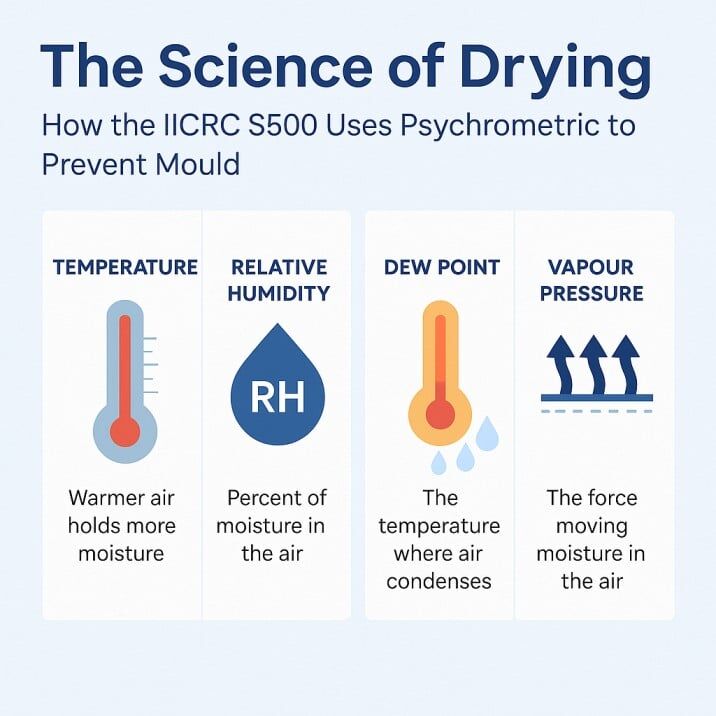The Science of Drying: How the IICRC S500 Uses Psychrometry to Prevent Mould
When a property suffers water damage, simply removing visible water is not enough.
Moisture hides in walls, subfloors, and building cavities, creating the perfect environment for mould growth, odours, and structural decay.
The ANSI/IICRC S500 Standard for Professional Water Damage Restoration provides a scientific framework—known as psychrometry—to control temperature, humidity, and airflow so that drying is both effective and safe.
What Is Psychrometry?
Psychrometry is the science of measuring and controlling the air–moisture relationship.
It examines four key factors:
-
Temperature – Warm air holds more moisture.
-
Relative Humidity (RH) – The percentage of moisture in the air compared to the maximum it can hold.
-
Dew Point – The temperature at which moisture in the air condenses into water.
-
Vapour Pressure – The driving force that moves moisture from wet materials into drier air.
By balancing these variables, restoration professionals can accelerate evaporation from wet materials while preventing secondary damage.
Why Psychrometry Matters in Drying
1. Preventing Mould Growth
-
Mould spores begin to colonize within 24–48 hours when RH exceeds 60%.
-
Psychrometric control keeps humidity below critical thresholds, cutting off mould before it starts.
2. Reducing Drying Time
-
Warm, dry air creates a stronger vapour pressure differential, pulling moisture out of wet surfaces faster.
-
Proper airflow prevents stagnant pockets where moisture lingers.
3. Protecting Building Materials
-
Overheating or rapid drying can cause wood warping, drywall cracking, or adhesive failure.
-
The S500 provides safe parameters to balance speed with material integrity.
The IICRC S500 Drying Process
The S500 defines a step-by-step protocol using psychrometry to guide equipment selection and job monitoring:
-
Extraction First
Remove standing water quickly.
Every litre extracted reduces drying time dramatically. -
Controlled Airflow
Place air movers to create turbulence across wet surfaces, encouraging evaporation. -
Dehumidification
Deploy refrigerant or desiccant dehumidifiers to capture moisture released into the air. -
Temperature Management
Use heaters or HVAC systems to maintain the optimal balance between evaporation and condensation. -
Continuous Monitoring
Measure RH, temperature, and moisture content daily to ensure conditions remain within S500 guidelines.
Key Equipment Guided by Psychrometry
| Equipment | Function |
|---|---|
| Air Movers | Increase evaporation by moving dry air across wet surfaces. |
| Refrigerant Dehumidifiers | Remove moisture from warm, humid air efficiently. |
| Desiccant Dehumidifiers | Work effectively in cooler conditions or specialty drying (Class 4). |
| Thermo-Hygrometers & Moisture Meters | Monitor temperature, RH, dew point, and material moisture content. |
How Reztor Applies the Science of Drying
At Reztor Restoration, our IICRC-certified technicians use advanced psychrometric monitoring to:
-
Calculate drying goals based on initial RH and temperature readings.
-
Determine the correct number of dehumidifiers and air movers.
-
Adjust equipment daily to maintain ideal conditions and prevent mould growth.
Every job is documented with moisture logs and psychrometric readings, giving insurers and property owners clear proof of a standards-based drying process.
Key Takeaways
-
Psychrometry is the backbone of professional drying—balancing temperature, humidity, and airflow to remove moisture safely.
-
Following the IICRC S500 ensures mould is stopped before it starts.
-
Continuous monitoring is essential to meet drying goals and protect building materials.
Need Professional Drying?
Water damage escalates within hours.
Contact Reztor Restoration for 24/7 psychrometry-driven drying that meets the latest S500 standards.
? Request Emergency Help
? 1800 739 867
